People
In a Q&A With Artnet, Tom Sachs Explains the Connection Between the Spacecrafts, Barbie Doll, and Vacuum Cleaner in His Current Show
Hint: they're all vessels traveling through space and/or time.

Hint: they're all vessels traveling through space and/or time.

Stephanie Eckardt

For those familiar with Tom Sachs, it comes as no surprise that the space-fixated artist’s latest exhibition is titled “Spaceships.” But not all the spaceships currently on view at the Upper East Side’s Acquavella Galleries—nor those that will follow at its Palm Beach outpost in February—are ones you’d ever expect to come across in outer space. Sachs has spent the past year and a half re-evaluating his notion of the spaceship, coming to view it as a vessel of both the cosmological and quotidian kind.
So how did Sachs begin to classify not just spacecrafts, but also everyday objects such as vacuum cleaners, Barbies, and turntables as spaceships? His broadening of the definition is in large part thanks to his foray into the world of ketamine therapy, which he considers a sort of “cheat code” for understanding the expansiveness of the universe and his existence.
Sachs suggests we dive right into it as he logged onto Zoom from his downtown Manhattan studio—on the condition that it’s clear that he uses psychedelics as a medically supervised means of exploration, never as an escape.
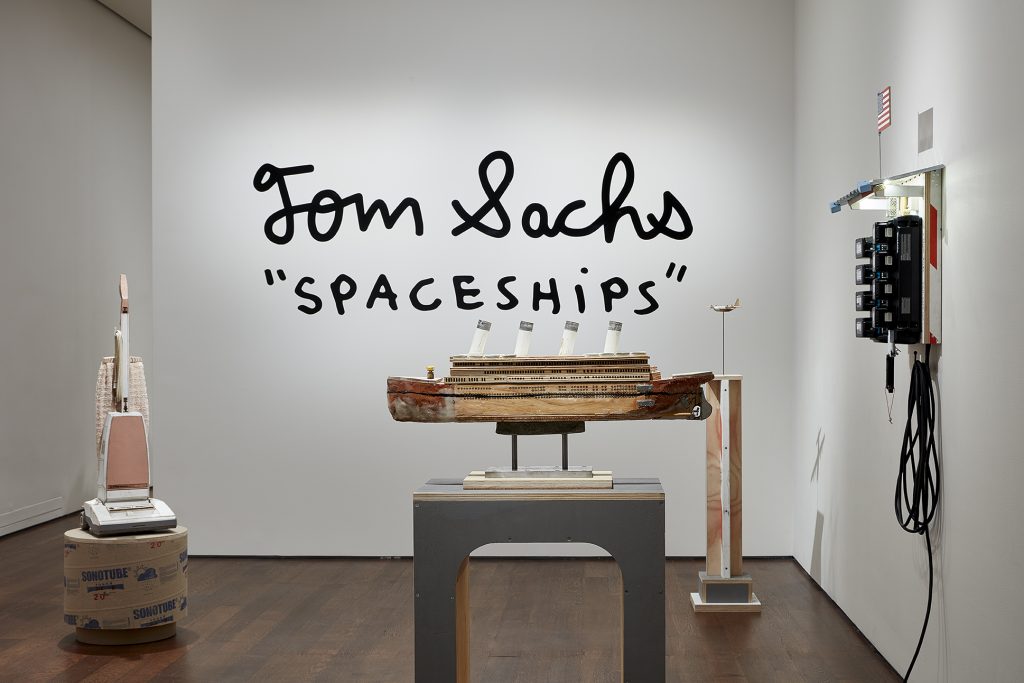
Installation view, Tom Sachs: Spaceships, Acquavella Galleries, New York, NY. Courtesy of Acquavella Galleries. Photograph © Kent Pell.
Like many who do ketamine therapy, you schedule your sessions well in advance and do them under medical supervision.
My point is that drug use and abuse are a fine line. The difference between scientists and juvenile delinquents is that the scientists call the police before they do the thing. It’s about understanding the conditions so that you can learn from it, [which is why] I take notes when I undergo psychedelic exploration.
What has ketamine therapy helped you realize?
When you go into another dimension, you’re temporarily aware that other dimensions of reality exist simultaneously to our consensual reality—the one that you and I are in right now. You don’t always have access to them, but when you’re tripping your balls off, you’re like, Whoa—this is happening, this is real. You have some semblance you’re still you or that you have a body, and you’re not completely divorced from your consciousness or your ego. And the reason why that’s valuable is that there’s enough connective tissue to this reality that you can compare.
The main takeaway for me is that there are other dimensions of reality—they’re just only accessible through this cheat code for a few hours. [The first experience] helped me understand the existence of my consciousness outside of the constraints of my body and my life. I saw myself floating through the cosmos, almost like in a Carl Sagan episode of Cosmos, and I was able to not only get outside of my nationalism and identity and masculinity, but outside of my body. I didn’t have any gender; I didn’t even know my name. I just felt a part of everything and greater connection, and there was a sense of wellbeing.
Would you mind sharing one of your notebook entries?
I was unprepared for my first trip, so I didn’t take notes. This is from my second trip on August 21, 2021: “I laughed. It was an uncontrollable laughter. My laugh sounded like someone I knew and I was so ashamed. I don’t want to be like him, and the association embarrassed me. Then I felt ashamed for being so judgmental. Then I was a skinny blue metallic, blue headed, stoner biker dude drugs culture Robert Crumb character. Not a geek, but a hunched-over stoner. I was a mean beetle man—fast and stupid. I was angry that I was wasting my high on this person and the beetle man. I was consumed by my body and the mask and a lot of judgment. I wanted and want the joy and connection with the universe that I felt on my first trip. My sense of oneness with the universe was so comforting that my forehead crease smoothed out and I accepted my own death. That awareness is key to my softness and kindness to myself and others. Must cultivate.”
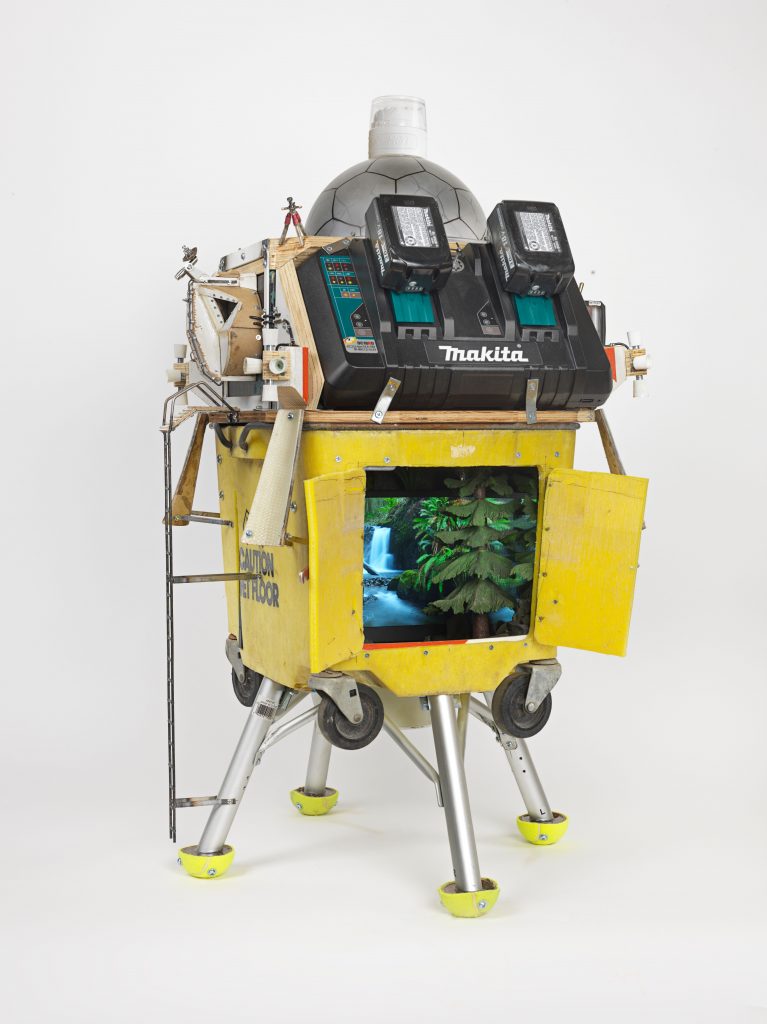
Tom Sachs, Generation Ship (2019–2021). Makita charger, tennis balls, steel hardware, White brand mop bucket, mixed media. Photo: Genevieve Hanson.
Thank you for sharing. How have those types of observations accelerated your broadening definition of the spaceship?
It goes back to when I went to the Air and Space Museum and saw an exhibition on Jules Verne’s From the Earth to the Moon, his book about three people who try to go to the moon. There was this leather-lined phone booth as you would build it in 1865, but the story’s exactly the same—that’s what we did 103 years later [in a different vessel]. It got me thinking about the kind of things that spaceships mean to me. I started to look around and understand something like the Titanic as a spaceship, or at least a time machine because it’s a pretty miraculous thing to get from London to New York in some titanic ship in only four days. It’s also a reminder of the imperialist side of things. Like, I’m not gonna make a show about spaceships without talking about the similarities between the Planetary Protection Protocol of 1957 and the Berlin Conference of 1884.
What about some of the other objects that you’ve come to consider spaceships?
The guillotine takes you to another dimension: death. And if you’ve ever mopped a floor, you’ll know that having a mop bucket will take you to another dimension of mopping quality. The turntable is about information through time and space. Like the human mind, it’s one of the few media devices that has random access to information. Films and tapes have linear access, but with a record, you just drop the needle and it goes. And then there’s the stroboscopic effect, where you can measure speed using light with the strobe on the side, which is something spaceships do.
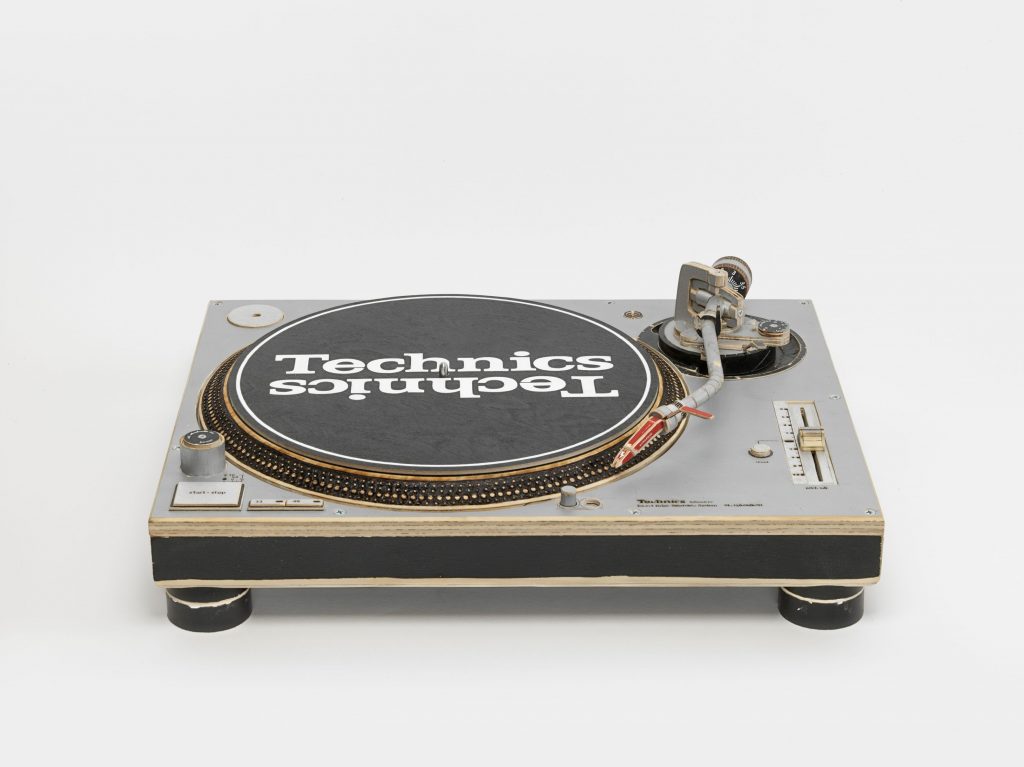
Tom Sachs, Technics 1200MK3D (2022). Plywood, epoxy resin, mixed media. Photo: Genevieve Hanson.
How does the vacuum cleaner fit in?
It has a motor and uses electricity to create a vacuum so that material can flow from one dimension to another—the filth of your carpet to the containment of a collection bag, where it accretes into a high density object. In the same way, the cosmos is made of mostly nothing: Over billions of years, little bits of dust start to gravitationally suck together and accrete to form planets, which, given just the right Goldilocks circumstances, can develop atmospheres that can support life and creatures with consciousness who can talk about it all. So in a sense, the vacuum cleaner is like a model of the universe. And you know, it’s also kind of a portrait of my wife [Sarah]. It’s a Hoover, and her last name is Hoover, and it’s tall and skinny—and wears Chanel.
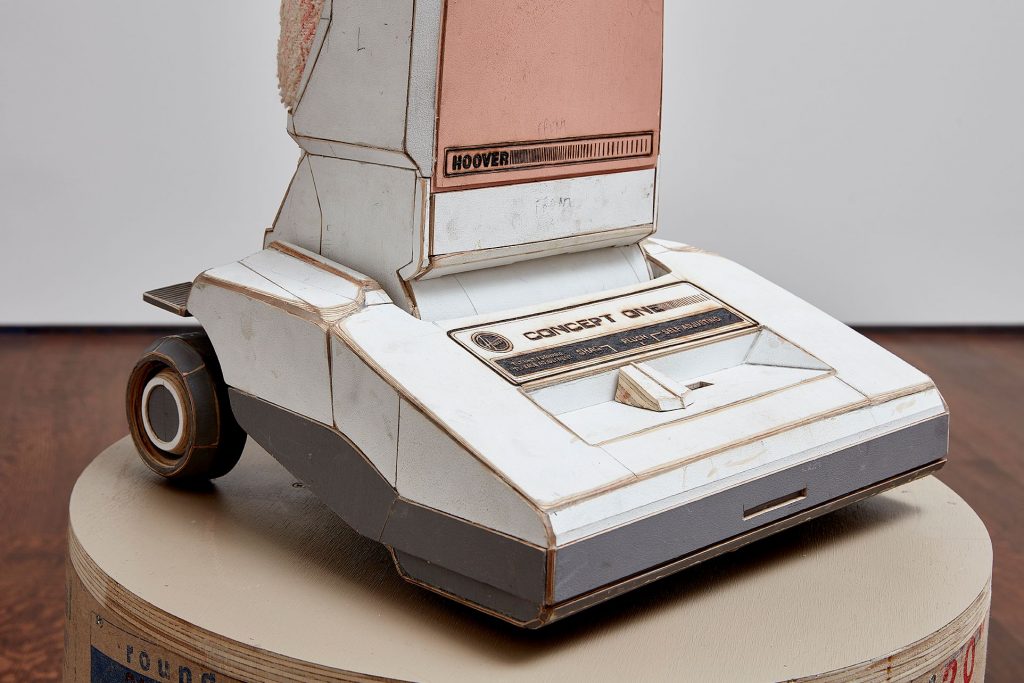
Tom Sachs, detail of Concept One (2021–2022). Mixed media. Photo: Kent Pell.
Not unlike a Barbie—another object featured in this exhibition, and one of just two works made before the past year or so. Why have you come to consider it a spaceship, too?
I think you could distill the universal language of nature down to math, chemistry, and genetic code. Genetic code is pretty mystical because we understand how we evolved from slime to creatures that talk about slime. And if Barbie is a consumerist representation of physical purity, she’s a spaceship, because she’s a vessel for genetic code. She represents us—an idealized us—with all of our body dysmorphia and best and worst qualities, warts and all. That’s who we are as consumerists, which is filled with those contradictions. I just think if you come straight out hating on Barbie for those things, you’re missing an opportunity to understand the nuance of why you hate her.
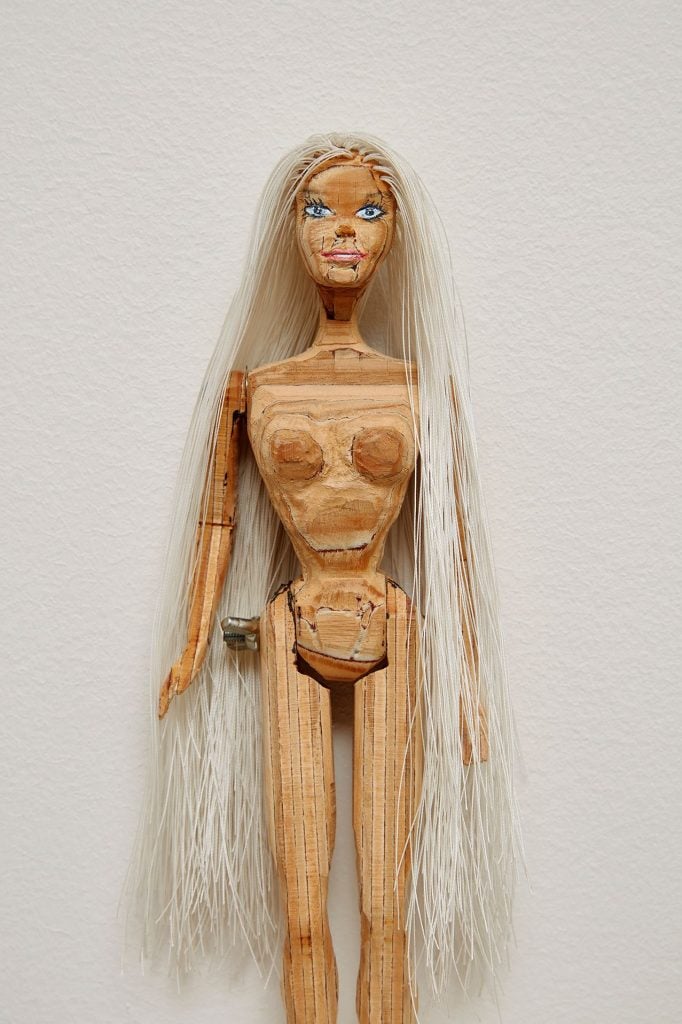
Tom Sachs, detail of Barbie (2013). Plywood, Vectran, steel hardware. Photo: Kent Pell.
Your work explores and embraces consumerism arguably as much as spirituality. How would you describe your version of the latter?
Well, they’re both a part of me, and I think the best thing an artist can do is their self-portrait. It’s complex, but I’m a devout Saganist. Carl Sagan’s Cosmos [a dozen-episode series about the cosmos] is my drug. If you want to start, start with his Pale Blue Dot speech. Being a devout Saganist means being a devout skeptic, so [I believe] extraordinary claims require extraordinary proof. Is there a God? I don’t know. I’m not an atheist; it’s gotta be agnostic until we’ve got proof.
Would you say that this is one of your spiritual bodies of work?
I don’t know. But it does mark a career change in that I think I’m going to stop the main core of my sculpture practice and make toys for my son, a few of which are in the show. His grandparents built him a pool in the backyard of the house that I grew up in, so I built him that sinkable Titanic. Then I fucked him over by selling that and the others—but you know, I don’t feel that bad because he doesn’t love any of the things that I make as much as his iPad. (Laughs.) One little trick I would tell [aspiring] artists is to make gifts. Through gifts, you channel your love for a person and are able to produce the most spiritual object you can make, because it isn’t connected to the corruption and sin of money.
There are American flags found all throughout this exhibition. Was there any hesitation before you stamped it on your more recent works?
You know, it’s funny—sometimes I cringe. But I think before you’re critical of consumerism, you have to be an active consumer. You know, before you start taking shit apart, you gotta come from it. I am who I am, and I think it’s important to be self examined. When I put an American flag on an artwork, it’s kind of a bragging thing—it’s like the ultimate national identity. But I hope that people understand that there is a sense of criticality because I ultimately don’t believe in borders. That’s why I did the Swiss Passport Office, where we issued thousands of fake Swiss passports for 20 euros each in London right after Brexit. We did not accept pounds, so people had to wait on line to get euros. I don’t believe in nationality, and I don’t believe in money—I think it’s an illusion by which we all live and die, just like borders.
Which reminds me of how you said your first experience with ketamine erased your sense of nationalism. Do you plan to continue the therapy, or do you think you’ve already learned from it what you can?
Even though it lasts only a couple hours, it’s still really hard to schedule. And I’m committed to a lot of things, so I haven’t done it in six months. Psychedelics really opened my mind about what a spaceship could be, but this show is just like a sliver in time. I’ve been making spaceships for three decades, and this is a body of work that will continue for years. I have three spaceships cooking in this room right now. I would like to continue it in the ways I would like to work on my jujitsu and my French and crypto skills, because I think that it’s valuable to learn other things and to explore the mind. But I’m also busy doing what I do best, which is make sculpture; I’m a black-belt bricoleur. And I’m very lucky and privileged that I found this vocation, this activity that is a real expression of me and all of my paradoxical ways of looking at the world.